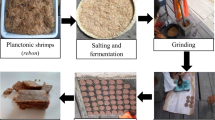Abstract
Introduction
Terasi is a fermented shrimp paste unique to Indonesia and is used in dishes to add umami and saltiness. In a previous study, the controlled fermentation of terasi was optimized using starters containing three bacterial isolates: Staphylococcus saprophyticus, Bacillus subtilis, and Lactobacillus murinus. However, the influence of controlled fermentation using these starters on the metabolites in terasi has not yet been studied.
Objectives
Therefore, this study aimed to investigate the effect of controlled fermentation on taste-related metabolites in terasi using a metabolomics approach.
Results
Non-targeted analysis indicated that amino acids contributed to variations during fermentation. Subsequently, targeted analysis of amino acids revealed that terasi subjected to controlled fermentation using a starter with a 2:1:2 ratio of S. saprophyticus, B. subtilis, and L. murinus, respectively, resulted in a product containing d-amino acids, such as d-Asp, d-Gln, and d-Leu that was unique when compared to other terasi products prepared using controlled fermentation. Genetic analysis of isolates from the terasi produced using controlled fermentation was also carried out, and this is the first study to suggest that Staphylococcus spp. has the potential to produce d-amino acids.
Conclusion
In conclusion, the ratio of bacterial species in starter cultures used in controlled fermentation influenced the amino acid profile of the product and starters with a higher ratio of Staphylococcus spp. may result in the production of d-amino acids.







Similar content being viewed by others
References
Andeta, A. F., et al. (2019). Development and validation of lactic acid starter cultures for enset (Ensete ventricosum) fermentation. LWT—Food Science and Technology, 115, 108462.
Ambarita, M. T. D. (2016). Considering the nutrional value of terasi and incorporating into the Indonesian diet. International Indonesia Forum.
Aryanta, W. R. (2000). Traditional fermented foods in Indonesia. Japanese Journal of Lactic Acid Bacteria, 10, 90–102.
Astuti, D. I., Taufik, I., Achnafani, D., & Priscila, E. S. (2018). Physiological profiling and microorganism community analysis of cirebon shrimp paste fermentation “terasi” using BIOLOGTM EcoPlate. Microbiology Indonesia, 12(1), 3.
Cappozi, V. (2017). Spontaneous food fermentations and potential risks. Fermentation, 3(49), 1–19.
Cevallos-Cevallos, J. M., et al. (2009). Metabolomic analysis in food science: A review. Trends in Food Science & Technology, 20, 557–566.
Chen, D., Ye, Y., Chen, J., & Yan, X. (2016). Evolution of metabolomics profile of crab paste during fermentation. Food Chemistry, 192, 886–892.
Ezekiel, O. O., Ogunshe, A., & Jegede, D. (2015). Controlled fermentation of cotton seeds (Gossypium hirsutum) for Owoh production using bacteria starter cultures. Nigerian Food Journal, 33, 54–60.
Hajeb, P., & Jinap, S. (2012). Fermented shrimp products as source of umami in Southeast Asia. Nutrition and Food Sciences, 10, 1–5.
Kobayashi, J. (2019). D-amino acids and lactic acid bacteria. Microorganisms, 7(12), 690.
Konya, Y., Taniguchi, M., & Fukusaki, E. (2017). Novel high-throughput and widely-targeted liquid chromatography-time of flight mass spectrometry method for d-amino acids in foods. Journal of Bioscience and Bioengineering, 123(1), 126–133.
Marcone, G. L., Rosini, E., Crespi, E., & Pollegioni, L. (2020). D-amino acids in foods. Applied Microbiology and Biotechnology, 104, 555–574.
Mok, W. K., et al. (2019). A metabolomic approach to understand the solid-state fermentation of okara using Bacillus subtilis WX-17 for enhanced nutritional profile. AMB Express, 9(1), 60.
Moon, S., Kim, C., & Chang, H. (2018). Heterofermentative lactic acid bacteria as a starter culture to control kimchi fermentation. LWT—Food Science and Technology, 88, 181–188.
Mutaguchi, Y., Kasuga, K., & Kojima, I. (2018). Production of d-branched-chain amino acids by lactic acid bacteria carrying homologs to isoleucine 2-epimerase of Lactobacillus buchneri. Frontiers in Microbiology, 9, 1540.
Mutaguchi, Y., Ohmori, T., & Oshima, T. (2015). 乳酸発酵とD-アミノ酸生産 [Lactic Fermentation and D-Amino Acid Production]. 化学と生物 [Chemistry and Biology] 53(1).
Nakamura, T., Tomita, S., & Saito, K. (2018). Metabolite profiling in dough during fermentation. Food Science and Technology Research, 24(3), 509–517.
Oh, D.-G., Jang, Y. K., Kim, J.-S., & Lee, C. H. (2016). Metabolomics reveals the effect of garlic on antioxidant- and protease-activities during Cheonggukjang (fermented soybean paste) fermentation. Food Research International, 82, 86–94.
Park, S.-E., et al. (2016). GCeMS based metabolomics approach of Kimchi for the understanding of Lactobacillus plantarum fermentation characteristics. LWT—Food Science and Technology, 68, 313–321.
Pereira, G. V. D. M., et al. (2015). Conducting starter culture-controlled fermentations of coffee beans during on-farm wet processing: Growth, metabolic analyses and sensorial effects. Food Research International, 75, 348–356.
Reynolds, J. (2020). 8: Bacterial Colony Morphology. Retrieved December 31, 2020, from https://bio.libretexts.org/Bookshelves/Ancillary_Materials/Laboratory_Experiments/Microbiology_Labs/Microbiology_Labs_I/08%3A_Bacterial_Colony_Morphology.
Ribeiro, L. S., et al. (2017). Controlled fermentation of semi-dry coffee (Coffea arabica) using starter cultures: A sensory perspective. LWT—Food Science and Technology, 82, 32–38.
Sato, A., Astuti, D. I., Putri, S. P., & Fukusaki, E. (2020). Quality improvement of semi-wet terasi by optimizing the starter culture ratio of controlled fermentation. Hayati Journal of Biosciences, 27(4), 320–329.
Sharma, R., et al. (2020). Microbial fermentation and its role in quality. Fermentation, 6, 106.
Surono, I. S., & Hosono, A. (1994). Chemical and aerobic bacterial composition of “terasi”, a traditional fermented product from Indonesia. Journal of the Food Hygienic Society of Japan, 35(3), 299–304.
Susiloningsih, R. (2008). The effect of starter (Lactobaccilus plantarum) concentration and fermentation time on the quality dan deterioration of terasi product. Jurnal PROTEIN, 15(2), 72–76.
Umakoshi, Y., et al. (2019). Automatic switching valve system to minimize variation of liquid chromatography-tandem mass spectrometry-based chiral amino acid profiling. Journal of Bioscience and Bioengineering, 128(6), 773–779.
Waryono, T. (2002). The history and social value characteristics of kampung laut segara anakan cilacap community. Kumpulan Makalah periode (pp. 1–17).
Author information
Authors and Affiliations
Corresponding author
Additional information
Publisher's Note
Springer Nature remains neutral with regard to jurisdictional claims in published maps and institutional affiliations.
Supplementary Information
Below is the link to the electronic supplementary material.
Rights and permissions
About this article
Cite this article
Sato, A., Putri, S.P., Astuti, D.I. et al. Metabolome analysis to investigate the effect of controlled fermentation on taste-related metabolites in terasi. Metabolomics 18, 44 (2022). https://doi.org/10.1007/s11306-022-01902-x
Received:
Accepted:
Published:
DOI: https://doi.org/10.1007/s11306-022-01902-x




